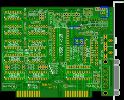Reply 180 of 590, by Fagear
- Rank
- Member
wrote:fantastic work Fagear - very professional!
Thanks.
wrote:, what soldering iron were you using? I think I need to upgrade mine.
goot PX-201 (~230V 70W, temperature control)
wrote:You mention daughter boards - what plans/ ideas do you have for those? Something like DSPs for effects?
Well, I have thought about typical power amplifier. Some 1-2W mono IC, pair of capacitors and mini-jack.
There was mentioned SPDIF-out converter on phantom.sannata.ru as possible option.
There are digital power (+5V, GND) pins (marked "PWR_VCC"), analog power (+9 or +12 V) pin (marked "PWR_VDD") and audio output pins (two pins marked "AUDIO OUT").
